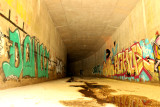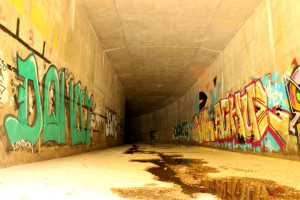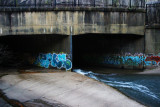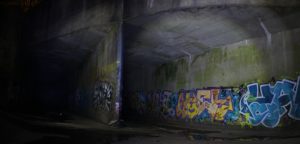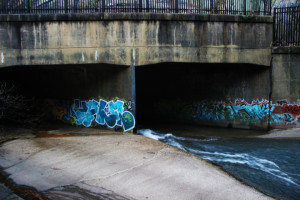The intake tunnels are of the modern rectangular barrel conduits like shape. They are approximately 4.5-5.5 meters (15-18ft) high and 5.5-6.0 meters (18-20ft) wide. These tunnels were constructed in the late 1950’s. There were constructed to encaspulate the river further more, to make way for the Jones Falls Expressway (JFX) / Interstate 83 which is immediately overhead. The dry weather flow is channeled into the western conduit and always runs at velocity. Its not uncommon for the river to overflow into the center conduit during periods of heavy precipitation. The eastern conduit typically remains dry, except for small streams of water that leak out of the walls from the Interstate 83 above. During Baltimore’s flood of July 2016, the river was observed flowing into the Eastern conduit and wrecked havoc at the end of the central conduit prior to the first Junction Chamber.
Once you take the decision to enter into the Mouth of Jonesy, your senses will quickly be inundated by unworldly external stimuli. The world around you will quickly transform its self into a foreign unforgiving environment. The explorer will quickly realize, “Humans do not belong in here, this is a no mans land”. Your instincts are not far off as this is an area on earth that was not designed for human life. If you scream, no one will hear you. Jonesy will swallow your reverbs. The explorer may notice the most significant and immediate environmental change is the overwhelming acoustics that this part of earth produces. At this point, you are positioned directly underneath of an Interstate. Shortly thereafter that the roar of diesel locomotives passing over the earth, 20 meters above your skull, penetrates your chest.
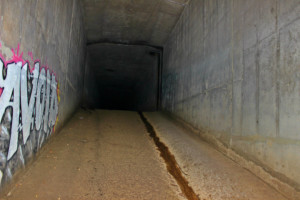
AVOID on the left.
A strong steady wind sweeps the face of the explorer. The breath of Jonesy himself. The natural barometrically-driven breathing of the tunnel. As air quality was one of the chief safety concerns of the explorer, this cool, dry & non-malodorous wind would provide a short lived psychological comfort of what lies down below.
As the explorer continues to push forward, the tunnel takes a gradual, slight bend to the east (bending left). The acoustics begin to change significantly. Which in turn just intensifies everything. The explorer would start hearing a dull yet overwhelming, roar that only increases in decibels as they get nearer to the source. Adrenaline glands running on full blast, the tunnel starts to straighten met with a swift downgrade. At this point, it is evident that the source of this noise is water that lies down at the bottom of this concrete downgrade. Depending on what lighting gear you have, you will notice there is an straight, divider at the bottom. The ceiling height begins to increase as the explorer travels down this decline, onward to the next section.
At the bottom of this decline brings the explorer to Junction Chamber 1 of this massive storm sewer. Known as, Triple Barrel Hall. Its where the 3 barrel conduits/tunnels turn into 2 massive ones known as JFX Diversion Tunnels. It is estimated to be about 175-200meters deep inside.
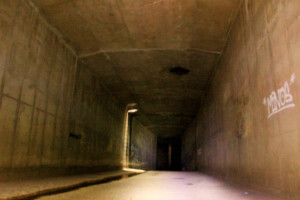
Approaching Triple Barrel Hall, Junction Chamber I
The Mouth of Jonesy: Entrance
Jonesy’s Nares: Tunnel Section I
Triple Barrel Hall: Junction Chamber I
Penn Station’s Chasm Hall: Tunnel Section II
Goliath Chamber: Junction Chamber II
Hendrick’s Folly : Guilford Avenue Diversion Tunnel
Flume Chamber: Jonesy’s Last & Final Run
WARNING!!!
Many of the environments & areas presented on this website are hazardous, and were only entered on the basis of extensive training, experience and planning. Do not try to access these sites / tunnels / storm sewers , they should not be trifled with. The intent of these pages are to provide historical documentation. An explorer already risked their life, so that you can explore virtually from home… so stay safe, and stay away! Consider this neither a disclaimer, nor a recommendation.
